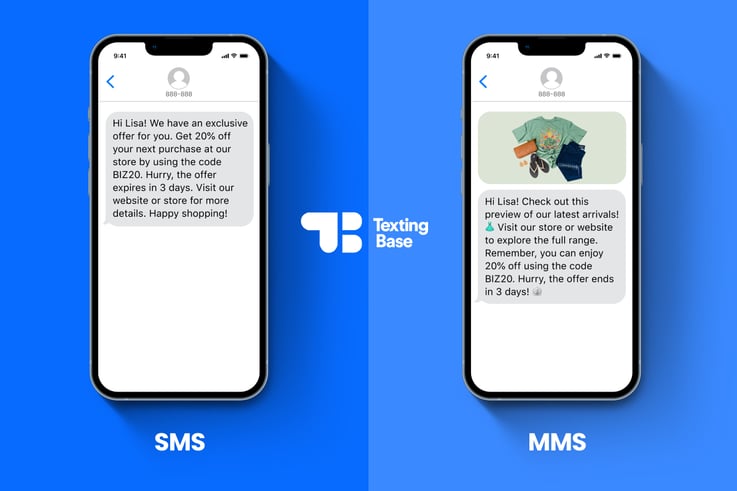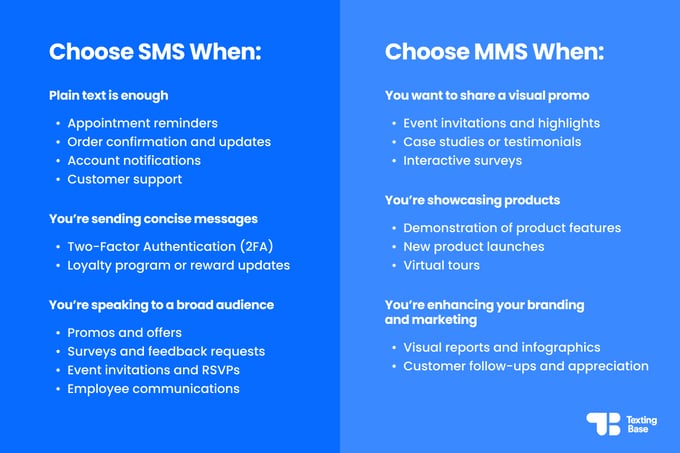SMS vs. MMS Messaging: Which One is Right For Your Business?
.jpg?width=860&name=jae-park-9_SaFlgwFdA-unsplash%20(1).jpg)
SMS and MMS are different kinds of text messages. As text marketing becomes increasingly popular, knowing which is best for your business is essential.
Business communication has evolved significantly with the rise of mobile technology. Two widely used messaging methods are SMS (Short Message Service) and MMS (Multimedia Messaging Service). Understanding the differences between SMS and MMS is crucial for businesses seeking effective communication channels.
Both enable the exchange of messages via mobile devices. However, SMS is primarily text-based, while MMS allows for including rich media content like images, videos, and audio files.
Today we’ll talk about the differences between SMS and MMS – their unique features, use cases, and how you can leverage each to enhance customer engagement and streamline communication.
- What is SMS
- What is MMS
- How is Texting Different From Apps Like WhatsApp or Messenger?
- SMS vs. MMS: Advantages and Disadvantages
- Which One Should You Choose – SMS or MMS?
What is SMS?
SMS enables the exchange of text messages between mobile devices. SMS only supports text – if your message contains images, audio, GIFs or emojis, it’s considered MMS. With SMS, users can send and receive concise messages typically limited to 160 characters per message. SMS operates over cellular networks and has become ubiquitous, allowing businesses and individuals to deliver quick and direct messages to recipients.
SMS offers a convenient and efficient way to connect and engage with customers, clients, and contacts, from appointment reminders and notifications to SMS marketing promotions and customer service updates.
Free yourself from character limits! Send longer messages with Texting Base.
SMS Use Cases
Here are ten business use cases for SMS:
- Appointment reminders: Send SMS notifications to remind customers of upcoming appointments, reservations, or important events.
- Order confirmations and updates: Send SMS messages to confirm customer orders and provide order updates, shipping details, or delivery notifications.
- Account notifications: Send SMS alerts to customers regarding important account information, like payment reminders, account balance updates, or security notifications.
- Promotions and offers: Send SMS messages to inform customers about exclusive deals, discounts, promotional offers, or limited-time sales.
- Surveys and feedback requests: Use SMS to collect feedback or gather opinions through text-based surveys.
- Event invitations and RSVPs: Send SMS invitations for corporate events, webinars, conferences or workshops, and allow recipients to RSVP via text.
- Customer support and service updates: Use SMS to provide customer support, address inquiries, or update customers on service disruptions, outages, or maintenance schedules.
- Two-Factor Authentication (2FA): Implement SMS-based 2FA to add an extra layer of security for user authentication and verification.
- Employee communications: Use SMS to send internal communications, updates, or emergency alerts to employees or specific teams within the organization.
- Loyalty programs: Send SMS messages to loyalty program members to notify them about reward points, special offers, or personalized promotions.

What is MMS?
MMS is an advanced messaging platform that allows users to send and receive multimedia content alongside text messages. Unlike SMS, MMS includes various media formats such as emojis, images, videos, GIFs, audio files, and even slideshows.
MMS provides a richer and more engaging messaging experience, allowing businesses and individuals to convey their message with visual impact. Whether showcasing products, sharing event highlights, or delivering visually captivating advertisements, MMS opens creative and interactive communication possibilities.
With MMS, businesses can leverage the power of multimedia to captivate their audience and effectively convey their message.
MMS Use Cases
Here are ten business use cases for MMS:
- Product demonstrations: Send MMS messages to showcase products through images or videos, providing customers with a visual demonstration of product features, functionality, or usage scenarios.
- Visual promotions and advertisements: Use MMS to deliver visually appealing promotional materials, such as high-res images, animated GIFs or short videos to grab customers' attention and drive engagement.
- Event invitations and highlights: Send MMS messages to invite customers or clients to corporate events, conferences, trade shows or special occasions, and share event highlights or sneak peeks through multimedia content.
- Visual testimonials and case studies: Share customer testimonials, success stories, or case studies through MMS to provide social proof and visually reinforce existing customers’ positive experiences.
- New product launches: Leverage MMS to create excitement around new product launches by sharing product images, teaser videos, or exclusive sneak peeks with customers.
- Virtual tours and property showcasing: Use MMS to provide virtual tours of real estate properties, hotel rooms or vacation destinations through images or videos, allowing potential customers to experience the location visually.
- Interactive surveys and polls: Engage customers through MMS by sending interactive surveys or polls that include visual elements, such as images or emoji-based responses, to gather feedback, opinions, or preferences.
- Coupons and special offers: Send MMS messages containing visually appealing coupons, discount codes, or exclusive offers to incentivize purchases, encourage customer loyalty, and drive sales.
- Visual reports and infographics: Share visual reports or infographics through MMS to present data, statistics, or key insights in a visually compelling and easily digestible format.
- Customer follow-ups and appreciation: Send personalized MMS messages to follow up with customers, express gratitude, or share unique visual content as a token of appreciation for their business.

How is Texting Different From Apps Like WhatsApp or Messenger?
Messaging applications like iMessage, Facebook Messenger, WhatsApp, and WeChat are all "Over The Top" (OTT) applications. Unlike traditional SMS and MMS messaging, these apps operate over the Internet and do not rely on cellular networks.
To send messages through these apps, the sender and recipient must have the same app installed on their respective devices. For instance, iMessage comes pre-installed on iPhones, so if your recipient is using an iPhone, your message will be sent via iMessage by default.
However, suppose the recipient does not have the same app or is not using an iPhone. In that case, your iPhone will automatically switch to SMS, indicated by a green bubble (instead of the typical blue bubble) in the iMessage interface.
SMS vs. MMS: Advantages and Disadvantages
If you’re on the fence about which to choose for your marketing strategy, let’s break down the advantages and disadvantages of each.
SMS Advantages |
SMS Disadvantages |
|
Widespread availability: SMS is supported by virtually all mobile phones, making it accessible to a wide range of users. |
Character limits: SMS messages are typically limited to 160* characters per message, which can be restrictive for conveying detailed or lengthy information. |
|
High open and read rates: Most SMS messages are read within minutes of receipt. |
Lack of multimedia support: SMS does not support multimedia content, limiting the visual or interactive elements that can be included in messages. |
|
Cost-effective: SMS is generally more affordable than other communication methods, making it a cost-effective solution for businesses. |
One-way communication: SMS is primarily designed for one-way communication, with limited interactive or real-time conversation options.** |
|
Reliable delivery: SMS messages have a high delivery success rate, ensuring that messages reach their intended recipients. |
* Texting Base won’t limit the length of your text messages
**Texting Base offers two-way SMS to keep the conversation going
MMS Advantages |
MMS Disadvantages |
|
Rich media content: MMS allows for the inclusion of multimedia content such as images, videos, audio files, emojis and slideshows, enabling businesses to deliver more visually engaging and interactive messages. |
Higher costs: MMS messages tend to be more expensive than SMS, as they transmit larger amounts of data. |
|
Enhanced communication: The ability to convey information through visuals and audio enhances the message's impact, helping businesses effectively communicate their brand, products, or services. |
Delivery reliability: MMS delivery can be less reliable than SMS, with potential issues such as message delays or failed deliveries due to network or device compatibility issues. |
|
Flexibility and creativity: MMS offers greater flexibility for creative expression, enabling businesses to develop innovative marketing campaigns, share product demonstrations, or deliver captivating advertisements. |
User experience: Recipients may experience longer load times for multimedia content, depending on their network connection speed and device capabilities. |
Which One Should You Choose – SMS or MMS?
Like many topics, the answer is – it depends. Sometimes SMS is right, and other times MMS is. Factors like the type of communication, budget, and branding can be decisive factors in which type of texting method you choose. Here are some tips to help you decide.
Choose SMS Messaging When:
- Text-based communication is sufficient: SMS is a cost-effective and efficient choice if your message primarily consists of plain text and does not require rich media content.
- You’re sending concise messages: SMS is ideal for short, quick communications, like appointment reminders, notifications, or updates.
- You’re reaching a broad audience: SMS works well when targeting a wide audience, including customers with older mobile devices that do not support MMS.
Choose MMS messaging when:
- Visual or multimedia content is essential: If you need to send images, videos, audio files, or any rich media content to enhance your message, MMS allows multimedia integration and provides a more engaging experience.
- You’re showcasing products or giving demonstrations: If your business involves showcasing products, providing visual demonstrations, or presenting visually appealing content, MMS can effectively convey your message with visual impact.
- You’re creating enhanced branding and marketing campaigns: MMS allows for greater creativity and customization, making it suitable for brand promotions, marketing campaigns, and delivering visually compelling advertisements.
Pro tip: It's important to note that the availability and capabilities of SMS and MMS may vary depending on the region, mobile carriers, and the devices used by your audience. Considering your business needs, target audience, and the content you wish to convey will help determine whether SMS or MMS messaging is the better choice.
Boost Your Reach With a Bulk SMS Provider Like Texting Base
Whether you choose SMS, MMS or a combination, both are valuable tools in your marketing strategy.
SMS is ideal for a minimalist, streamlined campaign and a smaller budget. In contrast, MMS allows you to send longer, eye-catching messages at a higher price point.
Texting Base offers an easy-to-use, streamlined platform that makes any marketing strategy a breeze! Find out how much Texting Base can do for your company by signing up for a free trial today!
.jpg)

